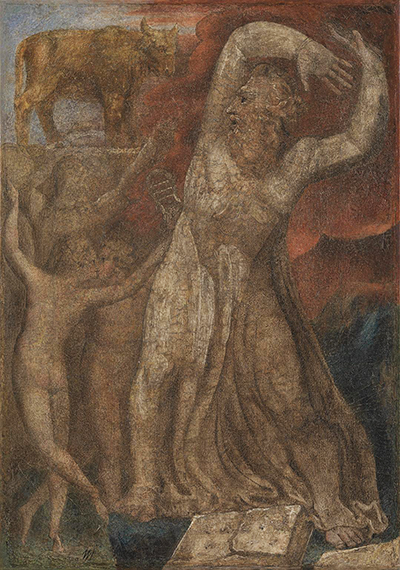Moses Indignant at the Golden Calf is a water-based creative tempera piece on canvas with a gum binding that William Blake created between 1799 and 1800.
Illustration
This artwork depicts a scene from the book of Exodus in the Old Testament. God summoned Moses to Mount Sinai to get the Ten Commandments. The two slabs of rock contained the inscriptions of the commandments. One of the demands in the Ten Commandments was to ensure that they served no other gods other than the one Moses did. In Moses' absence, ignorant of the instructions, the Israelites worshipped a golden calf statue. When Moses saw this, he became enraged and shattered the stone slabs. In Blake's mythology, a character named Urizen imposes iron rules on Man. Blake links Urizen with God and Moses, the originators of organized religion's laws, which Blake hoped for the abolition of.
The Technique
Tempera is a methodology used in painting that uses pigments mixed in an emulsion that is soluble in water, commonly egg yolk. Artists applied the process in Europe for exquisite art creations, mostly on lumber panels. The use of this technique commenced somewhere between the 12th and 13th centuries and continued to the 15th century. It is then that oil paints began to be used to create artistic art pieces.
Item Description
This creation on canvas illustrates several happenings. While Moses covers a more substantial part of the artwork's surface, the golden calf that was the centre of idolization stands grandly at the top left. Moses has his arms up in the air to signify his annoyance, seemingly almost as if he is about to strike them. The calf is illustrated in yellow gold, and the hue used on Moses is a whiter version of gold.
Immediately below the golden calf is a character looking up to it with arms raised in a praise-like position, illustrating worship. Below that is a couple, facing towards each other, stark naked, engaging in a fervent kiss. What that kissing scene reveals in the representation and its connotation to an indignant Moses is unclear. The unclothed couple seems oblivious to their surroundings.
The artist added a tinge of blue and red pigment at the centre besides Moses to break the monotony of goldish hues. Looking deeply into the reddish colour, it forms a cloud of smoke around Moses, kind of like it's his anger that has created the cloud of dust. It seeps into the top of the image towards the golden calf. The broken stone tablets are evident at Moses' feet.
Current Location
This tempera on canvas was endowed in 1986 by Ian L. Phillips and acquired by the Tate Gallery in London, the United Kingdom.




